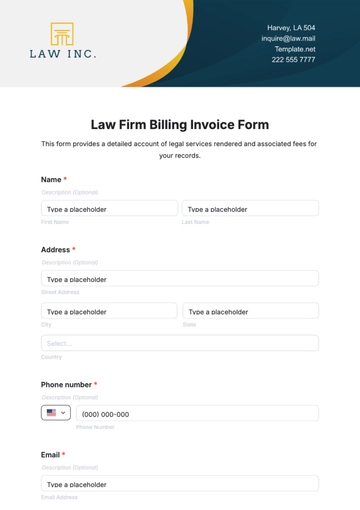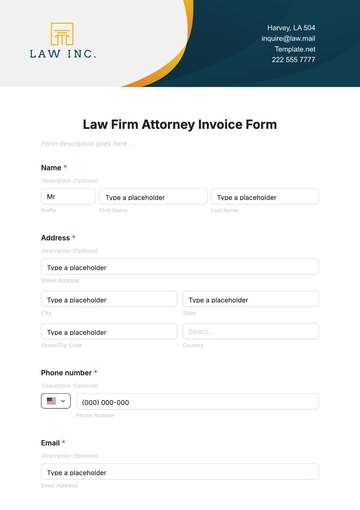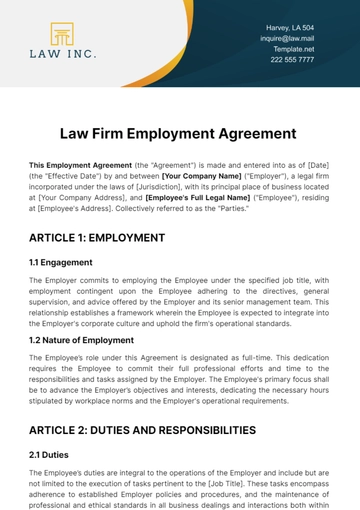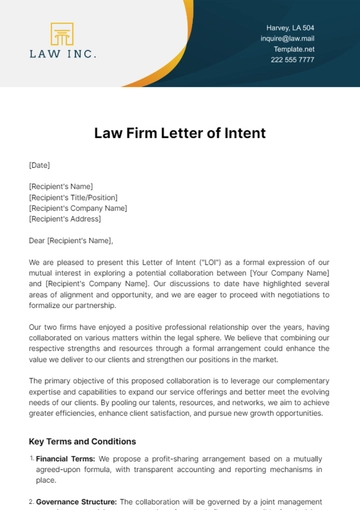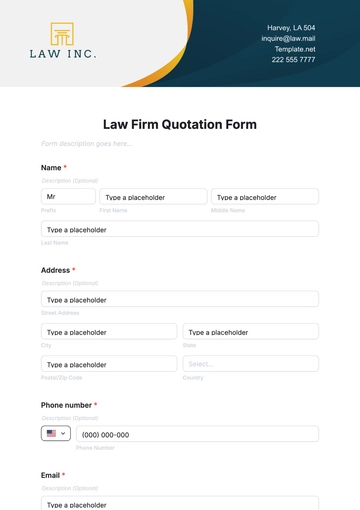Free Law Firm Digital Transformation Guide
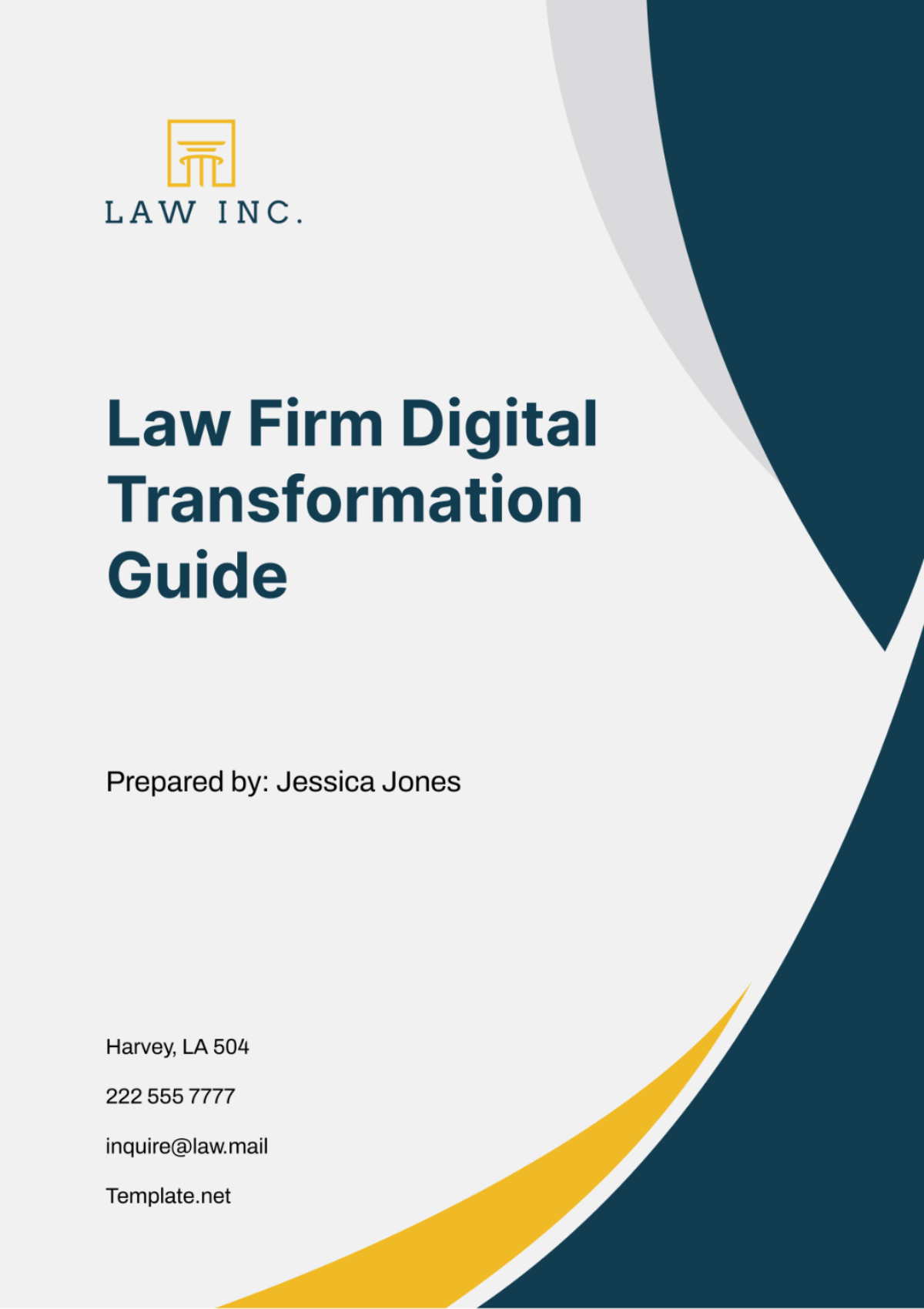
I. Introduction
Welcome to the Law Firm Digital Transformation Guide for [Your Company Name]. As we navigate the ever-evolving landscape of the legal industry, it is imperative to harness the potential of digital technology to enhance our legal services. This guide serves as a strategic blueprint for adopting cutting-edge tools that will revolutionize our operations, elevate client engagement, and ensure data security. Embrace this journey as we leverage technology to maintain a competitive advantage and deliver exceptional service.
Embarking on digital transformation requires a structured approach to seamlessly integrate technology into our legal practices. This guide outlines practical steps for evaluating your current technological infrastructure, identifying areas for improvement, and implementing effective digital solutions. By prioritizing client-centered technology, we not only streamline complex legal processes but also enhance the accuracy and accessibility of legal information, empowering our team to focus on strategic legal outcomes.
As [Your Company Name] progresses through this digital transformation, continual adaptation and learning are crucial. This document will also address the importance of training and development for our staff, ensuring that everyone is proficient in new technologies. Through this transformation, we aim to not only improve operational efficiency but also fortify client trust by providing secure, transparent, and responsive legal services. Let’s harness the power of digital innovation to redefine excellence in the legal domain.
II. Initial Assessment and Planning
In the Initial Assessment and Planning stage, we meticulously analyze existing operations within [Your Company Name] to determine the prime areas for digital enhancement. This section outlines the critical steps to assess our current practices, identify inefficiencies, and set strategic goals for integrating digital solutions. The information provided here will lay the groundwork for a successful digital transformation.
Step | Description | Expected Outcome |
|---|---|---|
Evaluation of Workflow & Documentation | Review current legal processes and documentation methods to pinpoint inefficiencies and outdated practices. | Clear understanding of areas needing digital upgrades. |
Bottleneck Identification | Analyze workflows to identify stages that cause delays or errors. Focus on repetitive and time-intensive tasks that could be automated. | List of key bottlenecks and error-prone areas. |
Technology & Infrastructure Assessment | Assess existing hardware, software, and network infrastructure to evaluate their effectiveness in supporting current and future legal tasks. | Detailed report on current tech capabilities and gaps. |
Consultations with Team Leaders | Conduct meetings with department heads and team leaders to collect insights on technological pain points and areas where they believe improvements are necessary. | Comprehensive feedback to guide digital tool selection. |
Goal Setting | Define specific, measurable, and achievable goals for digital transformation to guide the selection and implementation of new technologies. | Strategic objectives aligned with firm’s vision. |
This structured approach ensures a holistic understanding of our current capabilities and a clear path toward digital optimization. By aligning our goals with actionable insights, we can effectively enhance our legal services and client experiences.
III. Integrating Cloud-Based Solutions
Integrating cloud-based solutions is essential for [Your Company Name] to enhance document management and ensure the security of sensitive client information. This section outlines how adopting cloud technologies will transform our operations. We detail each platform's purpose and benefits, ensuring a strategic approach to digital enhancement for better service delivery and operational efficiency.
Platform | Purpose | Benefit |
|---|---|---|
Secure Document Storage | Document Accessibility | Provides quick access for authorized users and ensures robust data encryption for security. |
Collaborative Tools | Team Collaboration | Enables real-time editing and updates on case files, fostering efficient team collaboration. |
Cloud-Based Case Management Systems | Case Tracking | Streamlines case handling from inception to closure, enhancing case management efficiency. |
Accounting Software | Financial Management | Improves billing and accounting accuracy, offering a reliable financial management tool. |
Client Portals | Client Communication | Facilitates secure and transparent interactions between clients and lawyers. |
The adoption of these platforms will not only optimize our workflow but also secure client data and improve accessibility. This strategic integration represents a forward-thinking approach to leveraging technology in legal practice, enhancing both client satisfaction and operational effectiveness.
IV. Comprehensive Training Programs
Effective adoption of new technologies at [Your Company Name] hinges on well-structured training programs. This section explains the comprehensive approach to training our staff to proficiently use our digital tools. We outline various training modules designed to cater to different levels of tech proficiency, ensuring all team members are equipped to handle our upgraded systems confidently.
Training Module | Purpose | Details |
|---|---|---|
Basic and Advanced Document Management | Mastery of Document Systems | Train staff on both fundamental and advanced functionalities of new document management systems. |
AI-Driven Legal Research Tool Workshops | Efficient Legal Research | Provide practical workshops on utilizing AI tools for legal research to enhance case preparation. |
Technological Competency Credits | Continuous Legal Education | Offer credits for courses that improve technological skills, keeping legal professionals current. |
Scenario-Based Troubleshooting Training | Problem-Solving | Engage staff in real-life scenarios to practice troubleshooting common digital tool issues. |
Periodic Refresher Courses | Skill Maintenance | Conduct regular courses to update staff on new features and best practices as technology evolves. |
Through these targeted training programs, [Your Company Name] ensures that every team member not only understands how to use our new digital tools but can also leverage these technologies to improve their work efficiency and legal service delivery. This comprehensive training initiative supports our commitment to continuous improvement and technological adeptness in the legal field.
V. Continuous Monitoring and Adaptation
In the dynamic realm of legal technology, continuous monitoring and adaptation are crucial for [Your Company Name] to maintain its leadership position. This section outlines our strategy for staying current with technological advancements and ensuring our digital tools are effective and compliant with legal standards. We detail the processes for ongoing evaluation and improvement.
Activity | Purpose | Details |
|---|---|---|
Ongoing Tech Implementation Evaluations | Assess Effectiveness | Conduct regular assessments to evaluate the effectiveness of the current technology and identify improvement areas. |
Regular Feedback Loops with Staff | Practical Insights | Establish feedback mechanisms with staff to gain insights from daily technology use and identify usability issues. |
System Updates and Upgrades | Maintain Compliance and Efficiency | Regularly update and upgrade systems to align with evolving legal standards and technological advancements. |
Engagement with Industry Forums | Stay Informed on Emerging Technologies | Participate in industry forums and networks to gain early insights on emerging technologies and their potential impacts. |
Revising Training Materials | Keep Training Current | Continually revise training programs to incorporate new best practices and technological developments. |
This proactive approach ensures that [Your Company Name] not only adapts to changes but also anticipates future trends, fostering a culture of innovation and continual learning within our firm. By constantly evolving our practices, we enhance our service delivery and ensure our firm remains at the cutting edge of legal technology.
VI. Data Security and Compliance
In the digital age, the security and compliance of data are foundational to maintaining trust and operational integrity at [Your Company Name]. This section details the rigorous protocols and state-of-the-art technologies we will deploy to safeguard client information and ensure regulatory compliance. Our comprehensive approach includes policy development, the adoption of advanced security measures, and continuous staff training, all designed to fortify our defenses against cyber threats and data breaches.
Component | Strategy | Implementation Details |
|---|---|---|
Data Protection Policies | Policy Development and Implementation | Create and enforce robust data protection policies that comply with legal standards like GDPR and HIPAA. |
Security Technologies | Advanced Technological Deployment | Implement end-to-end encryption and multi-factor authentication to secure client data across all digital platforms. |
Regular Security Audits | Ongoing Evaluation | Conduct regular security audits to identify and rectify vulnerabilities, ensuring continuous improvement in security. |
Compliance Tools | Automated Monitoring | Use automated compliance tools to continuously monitor and enforce adherence to all applicable regulations. |
Staff Training | Education and Awareness | Provide ongoing training for all staff on the latest data security practices and compliance requirements. |
Through this structured and proactive approach, [Your Company Name] commits to upholding the highest standards of data security and compliance, ensuring that our clients' sensitive information remains protected in an increasingly digital world. This commitment not only enhances our firm’s reputation but also instills confidence among our clients, making it a critical component of our digital transformation strategy.
VII. Client Experience Enhancement
In the quest for digital excellence, enhancing client experience is paramount for [Your Company Name]. This section highlights our strategic focus on deploying client-centric technologies that ensure transparency, facilitate seamless communication, and deliver efficient services. With tools like client portals, AI-driven chatbots, and mobile applications, we aim to transform client interactions, thereby boosting satisfaction and fostering loyalty—an indispensable advantage in today's competitive legal market.
Technology | Purpose | Implementation Details |
|---|---|---|
Client Portals | Transparency and Communication | Introduce an intuitive client portal for real-time tracking, document exchange, and streamlined communication. |
AI-driven Chatbots | 24/7 Client Support | Deploy AI chatbots on our website and client portal to provide immediate responses to client inquiries anytime. |
Mobile Applications | Enhanced Accessibility | Develop and launch mobile applications that allow clients to access case information and updates on the go. |
Through these innovative solutions, [Your Company Name] commits to not just meeting but exceeding client expectations, ensuring every interaction is smooth, transparent, and responsive. These enhancements are crucial for nurturing lasting relationships and ensuring our clients feel valued and well-informed throughout their legal journeys.
VIII. Innovation and Technology Scouting
To maintain a competitive edge, [Your Company Name] prioritizes continuous innovation and proactive engagement with emerging technologies. This section elaborates on our strategy to establish an innovation hub that actively scouts and evaluates new technological advancements in the legal field. By setting up a dedicated team, collaborating with pioneers, and fostering a vibrant culture of innovation, we ensure our firm stays ahead of technological trends and integrates the most impactful solutions.
Strategy | Objective | Implementation Details |
|---|---|---|
Dedicated Innovation Team | Technology Exploration | Establish a team focused on identifying and exploring emerging technologies like blockchain and artificial intelligence. |
Collaboration with Tech Providers | Pilot Testing and Partnerships | Partner with technology providers and legal tech startups to pilot and evaluate new tools in a controlled environment. |
Innovation Culture Initiatives | Internal Engagement and Creativity | Organize hackathons and internal idea-sharing forums to encourage staff participation in innovation and technology adoption. |
Through these strategic initiatives, [Your Company Name] not only stays informed about potential technological disruptions but also prepares to integrate advancements swiftly and effectively. This proactive approach to innovation ensures our services remain relevant and superior, positioning us as leaders in the digital transformation of the legal sector.
IX. Performance Metrics and ROI Analysis
As [Your Company Name] embarks on its digital transformation journey, measuring and analyzing the return on investment (ROI) and other performance metrics becomes essential. This section discusses the establishment of clear key performance indicators (KPIs) and the use of sophisticated analytics tools to monitor these metrics. Regular ROI analyses will help us evaluate the effectiveness of our digital initiatives in enhancing firm efficiency, reducing costs, and driving revenue growth.
Metric | Purpose | Implementation Details |
|---|---|---|
Client Retention Rates | Customer Satisfaction and Loyalty | Monitor changes in client retention rates to gauge the impact of digital tools on client satisfaction. |
Case Resolution Times | Operational Efficiency | Track the average time taken to resolve cases before and after implementing digital solutions. |
Digital Engagement Levels | Client and Staff Interaction with Digital Tools | Assess how frequently and effectively both clients and staff engage with our digital platforms. |
ROI Analysis | Financial Performance | Conduct quarterly financial reviews to evaluate the monetary benefits derived from digital investments. |
Utilizing analytics dashboards, these metrics will be continuously monitored, providing real-time insights that drive strategic decision-making. By rigorously assessing these KPIs, [Your Company Name] ensures that our digital transformation aligns with our goals of increased efficiency and client-centered service, while also maximizing economic benefits. This structured approach to performance measurement underscores our commitment to accountability and excellence in the digital era.
X. Conclusion
This Law Firm Digital Transformation Guide is instrumental in positioning [Your Company Name] at the forefront of technological advancements in the legal field. By adhering to the structured strategies outlined, we are set to enhance our operational efficiencies and data security. The transformation journey will empower us to meet the evolving demands of the legal market, ensuring we deliver superior service quality that aligns with the expectations of our tech-savvy clients.
Our commitment to embracing digital tools is not just about adopting new technologies but is a strategic move towards building a more resilient and innovative practice. This guide serves as a roadmap for all team members to understand and implement digital solutions that streamline processes and improve client interactions. As we progress, our firm will experience significant improvements in workflow, client satisfaction, and overall competitiveness in the legal sector.
By successfully integrating the principles and actions described in this guide, [Your Company Name] will not only sustain but also enhance its market position. Continuous monitoring and adaptation to technological trends will ensure that our services remain relevant and effective. Let us move forward with confidence, knowing that our commitment to digital excellence will drive our success and uphold our reputation as a leader in the legal industry.
- 100% Customizable, free editor
- Access 1 Million+ Templates, photo’s & graphics
- Download or share as a template
- Click and replace photos, graphics, text, backgrounds
- Resize, crop, AI write & more
- Access advanced editor
Explore the future of law practice with Template.net's Law Firm Digital Transformation Guide Template. Fully editable and customizable, this guide easily adapts to your firm's unique needs. Unleash an effective digital strategy with our template editable in our AI Editor Tool. Drive innovation, enhance productivity, and achieve remarkable client satisfaction – lead your law firm towards a more progressive future. Start your digital transformation journey now.














